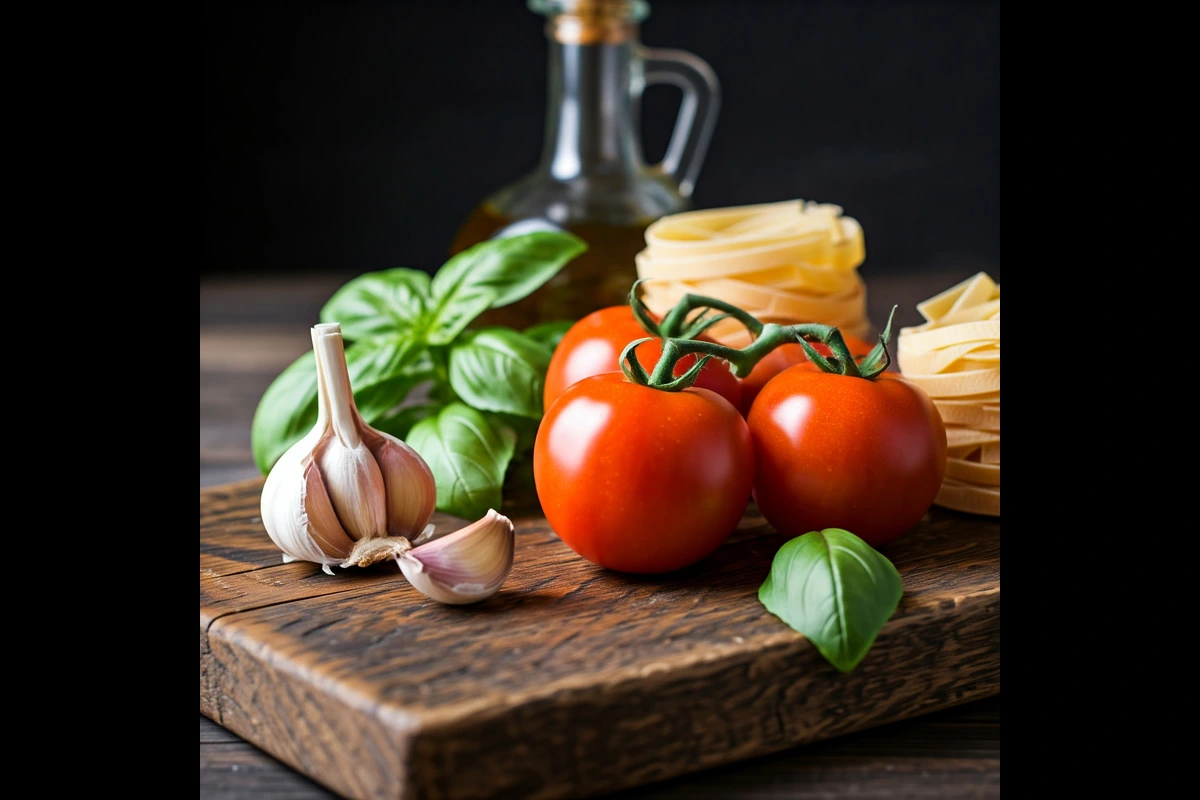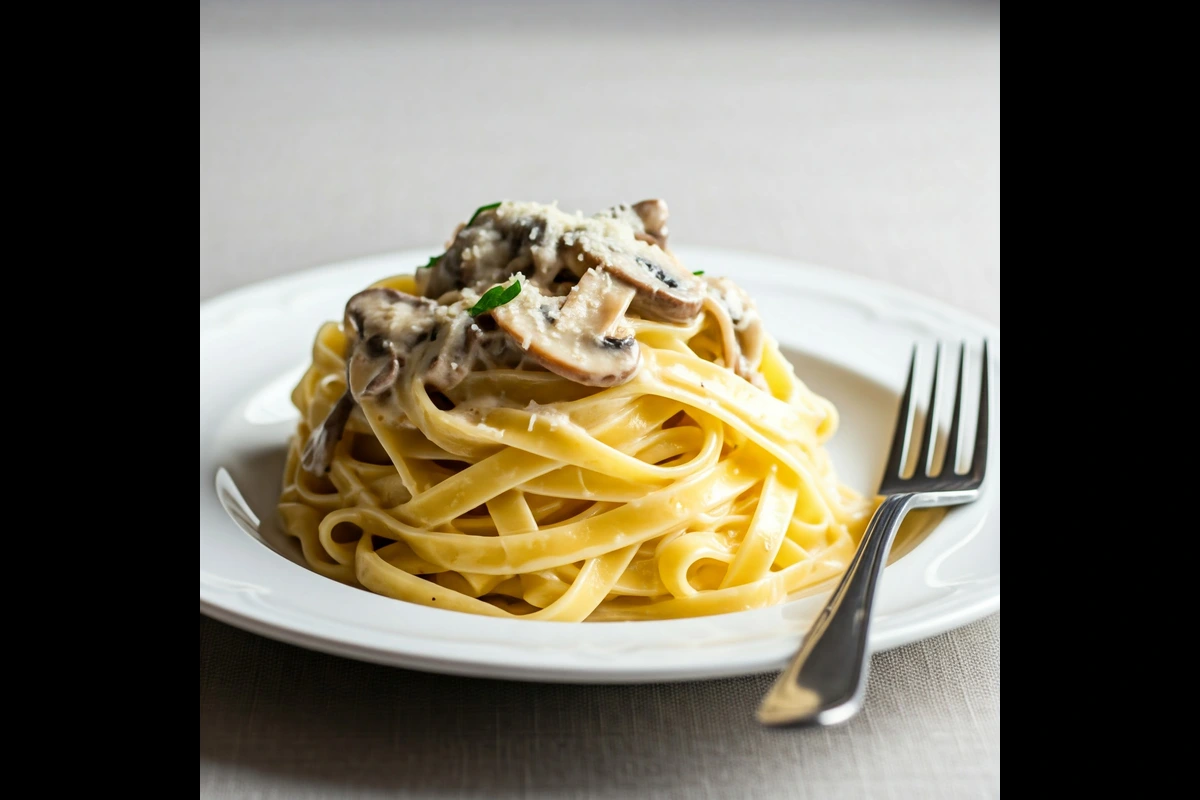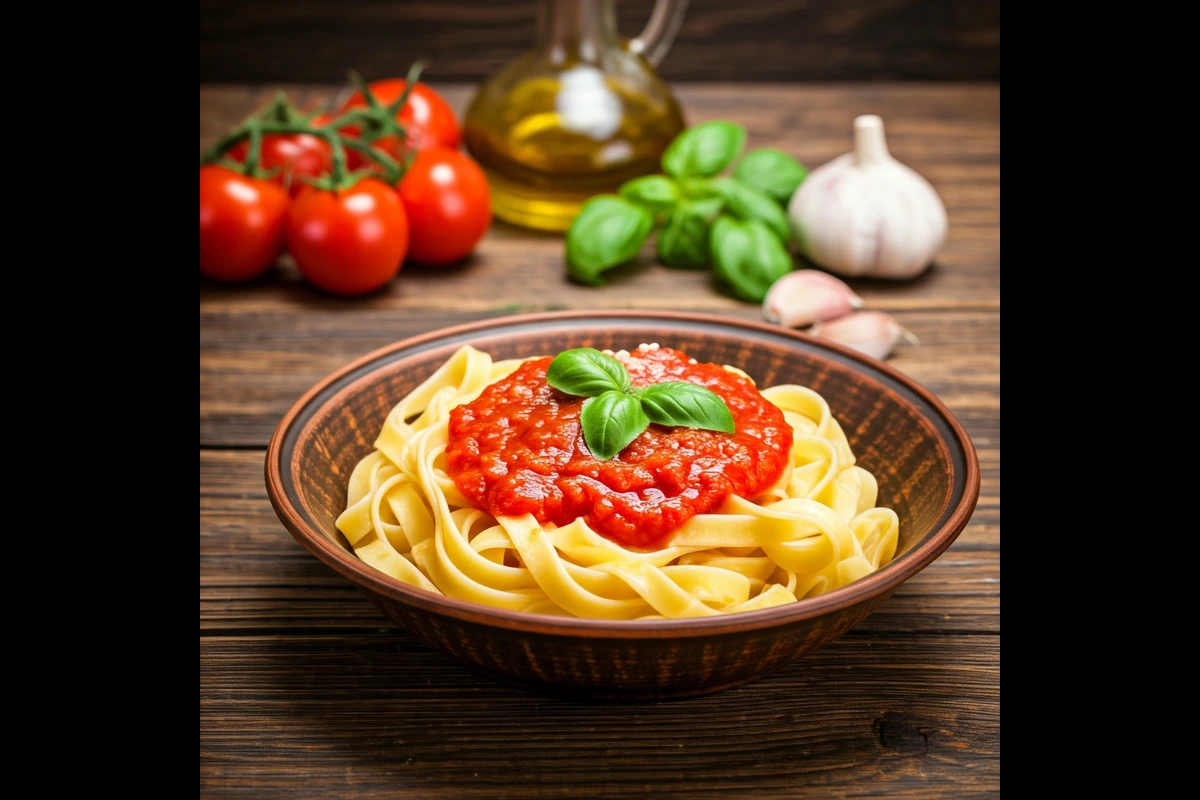Tagliolini, a delicate type of Italian pasta, offers endless possibilities when it comes to sauces and pairings. In this comprehensive guide, you’ll discover everything about Tagliolini sauce, from traditional recipes to modern twists, and tips on the best ingredients to use. Whether you’re a beginner or a seasoned home cook, this article will take you through step-by-step instructions and help you explore a variety of mouth-watering pasta sauces that will make your meals unforgettable.
We’ll dive into the perfect ways to prepare Tagliolini sauce, share some tasty variations, and give you tips on pairing it with the right wines and pasta. Let’s get started!
Introduction to Tagliolini and Its Signature Sauces
Tagliolini, known for its thin, flat strands, is a close cousin of tagliatelle but finer in texture. Originating from Italy’s northern regions, it’s traditionally paired with light sauces that cling well to its shape. But what really makes Tagliolini stand out is the versatility of sauces that complement it.
What Is Tagliolini?
Tagliolini is an egg-based pasta, typically made fresh to enhance its rich, silky texture. It’s flatter and thinner than spaghetti but still holds sauces beautifully, making it a go-to for many Italian dishes. This pasta can be served with a range of sauces, from creamy to tomato-based or even seafood variations.
The Role of Sauces in Italian Cuisine
In Italy, pasta isn’t just about the noodles—it’s about the harmony between the pasta and sauce. Each region has its own distinct approach to sauces, and with Tagliolini, the emphasis is often on creating light, flavorful combinations that allow the pasta’s texture to shine. Whether it’s a delicate butter and sage sauce or a rich cream sauce, Italian cuisine revolves around this simple but impactful combination.
Popular Sauces Paired with Tagliolini
Tagliolini’s versatility is its secret weapon. Some of the most popular sauces include:
- Cream-based sauces, which provide a velvety smoothness that complements the pasta’s delicate texture.
- Tomato-based sauces, like marinara or Pomodoro, that are light yet flavorful.
- Seafood sauces, such as a lemon-butter shrimp sauce, that bring a touch of luxury to the table.
In the following sections, we’ll delve into the details of making these sauces, explore unique variations, and guide you through the process of perfecting your Tagliolini sauce game. Whether you’re looking to master a traditional recipe or try something new, this guide has you covered.
The Traditional Tagliolini Sauce Recipe
For many, nothing beats the taste of a homemade Tagliolini sauce. The balance between fresh ingredients and simple techniques creates a rich, comforting flavor that complements the delicate texture of Tagliolini pasta. Let’s walk through the traditional recipe for making this versatile sauce from scratch.
Ingredients for a Classic Tagliolini Sauce

The beauty of Tagliolini sauce lies in its simplicity. Here’s what you’ll need for a basic sauce:
- 4 tablespoons of extra virgin olive oil
- 2 cloves of garlic, finely chopped
- 200g of cherry tomatoes (or fresh plum tomatoes)
- Salt and pepper to taste
- A handful of fresh basil leaves
- Parmesan cheese for garnishing (optional)
If you want to add a richer flavor, a splash of white wine or a spoonful of heavy cream can elevate the dish. These basic ingredients make for a light, fresh sauce that pairs perfectly with the delicate strands of Tagliolini.
Step-by-Step Cooking Instructions
- Prepare the tomatoes: Blanch the cherry tomatoes in boiling water for a minute, then peel and chop them. You can also skip peeling if using smaller tomatoes for a more rustic feel.
- Sauté the garlic: Heat the olive oil in a pan over medium heat. Add the chopped garlic and let it cook until it becomes golden and fragrant. Be careful not to burn the garlic as it can turn bitter.
- Add the tomatoes: Toss in the chopped tomatoes, season with salt and pepper, and stir well. Let the tomatoes cook down for about 10-15 minutes until they soften and release their juices.
- Simmer and blend flavors: Stir occasionally, crushing the tomatoes lightly with a spoon. If you prefer a smoother sauce, you can blend the mixture. However, leaving it slightly chunky gives a lovely texture.
- Finish with basil: Once the sauce has thickened, tear the fresh basil leaves and stir them in. Let them infuse for a couple of minutes before removing the sauce from heat.
Tips for Perfecting the Sauce
- Use fresh tomatoes: Fresh, ripe tomatoes give your Tagliolini sauce a sweet, tangy taste. If tomatoes aren’t in season, opt for high-quality canned ones.
- Seasoning: Don’t hesitate to adjust the seasoning. A dash of sugar can balance out the acidity of the tomatoes, and a sprinkle of chili flakes adds a nice kick.
- Enhancements: To take it up a notch, try adding anchovies or capers for a Mediterranean twist, or toss in some cooked prawns or clams for a seafood variation.
This basic Tagliolini sauce recipe can easily be modified to suit your preferences, making it the perfect canvas for culinary creativity.
Variations of Tagliolini Sauce
One of the best things about Tagliolini pasta is its adaptability. While the traditional tomato sauce is a favorite, there are several delicious variations to explore. From creamy indulgence to seafood delights, let’s dive into a few popular types of Tagliolini sauce.
Cream-Based Tagliolini Sauces

Cream-based sauces are a hit for those who prefer a rich, velvety texture. The mild flavor of Tagliolini works well with these sauces, which coat the pasta beautifully.
- Tagliolini al Limone: This zesty, refreshing sauce combines heavy cream with lemon zest and juice. The tanginess of the lemon balances the richness of the cream, making it perfect for summer meals.
- Mushroom Cream Sauce: Earthy and satisfying, a mushroom cream sauce is made by sautéing mushrooms in butter and garlic, then adding cream and a splash of white wine. Top it off with Parmesan for a heavenly finish.
Tomato-Based Tagliolini Sauces
If you prefer something lighter, tomato-based sauces are a great match for Tagliolini. They can range from simple marinara to more complex flavors.
- Arrabbiata: This spicy tomato sauce, made with garlic, red chili, and olive oil, adds a fiery kick to your Tagliolini. The heat of the peppers complements the sweetness of the tomatoes.
- Pomodoro Sauce: A lighter version of the traditional tomato sauce, Pomodoro uses fewer ingredients, focusing on the purity of the tomatoes. It’s an excellent choice when you want a quick and fresh meal.
Seafood Tagliolini Sauces
Seafood and Tagliolini are a match made in heaven. The lightness of the pasta allows the delicate flavors of the seafood to stand out.
- Shrimp and Lemon Butter Sauce: In this luxurious variation, shrimp are sautéed in a butter, garlic, and lemon sauce. A splash of white wine brings all the flavors together.
- Clam Sauce: A classic Italian recipe, clam sauce is prepared with fresh clams, white wine, garlic, and parsley. It’s a fantastic choice for those who love seafood with a touch of elegance.
Vegetarian and Vegan Options
For those following a plant-based diet, there are plenty of ways to enjoy Tagliolini sauce without animal products.
- Vegan Pesto: Made from fresh basil, pine nuts, garlic, and olive oil, pesto is a vibrant, flavorful option. Swap out Parmesan for nutritional yeast to keep it vegan.
- Roasted Vegetable Sauce: A hearty option that involves roasting vegetables like zucchini, bell peppers, and tomatoes before blending them into a rich, flavorful sauce.
The versatility of Tagliolini means you can experiment with endless variations of sauces, each bringing out different textures and flavors. Whether you’re in the mood for something creamy, spicy, or seafood-packed, there’s a perfect sauce for every occasion.
Best Ingredients for Tagliolini Sauces
Creating a perfect Tagliolini sauce begins with selecting the best ingredients. From choosing fresh vegetables to picking the right olive oil, each component plays a crucial role in the overall flavor of the dish.
Choosing the Best Fresh Ingredients
The secret to a great Tagliolini sauce lies in using high-quality, fresh ingredients. Whether it’s tomatoes, basil, or garlic, freshness can make or break your sauce.
- Tomatoes: Opt for fresh, ripe tomatoes. In-season tomatoes, like plum or San Marzano, provide a natural sweetness that elevates your Tagliolini sauce. For a deeper flavor, roast the tomatoes before adding them to your sauce.
- Garlic and Onions: Always use fresh garlic cloves and onions for a rich, aromatic base. Avoid pre-chopped garlic as it loses its flavor over time.
- Basil and Other Herbs: Fresh herbs, especially basil, add a burst of color and aroma. You can also incorporate oregano, thyme, or parsley depending on the sauce variation.
Selecting Olive Oil and Herbs for Tagliolini Sauces
When it comes to Italian sauces, olive oil is a cornerstone ingredient. It not only binds the ingredients but also imparts a distinct richness.
- Extra Virgin Olive Oil: Always use extra virgin olive oil for its superior flavor and health benefits. It works well for sautéing garlic or as a finishing drizzle to enhance the final dish.
- Herb Selection: Basil is traditionally the herb of choice for tomato-based Tagliolini sauce, but don’t be afraid to experiment with rosemary or sage if you’re creating a cream-based or butter sauce.
Regional Ingredients That Elevate the Flavor
Depending on the regional inspiration behind your Tagliolini sauce, consider using locally-sourced ingredients to add an authentic touch.
- Italian Cheeses: Parmesan and Pecorino Romano are great for adding a salty, nutty flavor to cream-based sauces.
- Seafood: If you’re preparing a seafood Tagliolini sauce, opt for fresh shrimp, clams, or even anchovies to bring the taste of the Mediterranean to your table.
For more tips on selecting fresh ingredients, check out the Tagliolini ingredients and recipe tips article.
Pairing Tagliolini Sauce with Pasta and Wine
The right pairing can take your Tagliolini sauce to the next level. Whether you’re choosing pasta to enhance the sauce or selecting wine to complement the dish, these pairings ensure a delightful dining experience.
Perfect Pasta Pairings with Tagliolini Sauce
Although Tagliolini is traditionally served with delicate sauces, it pairs well with a wide variety of pasta types, depending on the texture and sauce you’re aiming for.
- Tagliolini: Naturally, the best match for Tagliolini sauce is the pasta itself. Its thin strands make it perfect for light sauces like aglio e olio or a simple marinara.
- Tagliatelle or Fettuccine: If you want to experiment, broader pasta shapes like tagliatelle or fettuccine work well with thicker, creamier sauces. They can hold heavier ingredients such as mushrooms or sausage.
- Pappardelle: For heartier, meat-based sauces, pappardelle’s wider surface area can support rich flavors like a creamy mushroom or ragu-style sauce.
Best Wines to Accompany Tagliolini Dishes
Pairing wine with Tagliolini sauce can elevate the flavors of your meal. Italian wines, in particular, are perfect for this.
- White Wine: For lighter Tagliolini sauces, like those based on lemon, butter, or seafood, a crisp white wine such as Pinot Grigio or Sauvignon Blanc offers a refreshing balance.
- Red Wine: If your sauce is tomato-based or includes meat, a light red wine like Chianti or Barbera pairs beautifully with the acidity and richness of the dish.
- Sparkling Wine: If you’re serving a cream-based or cheesy Tagliolini sauce, a sparkling wine like Prosecco can cut through the richness and provide a delightful contrast.
Balancing Flavors with Side Dishes
To create a complete meal, consider adding simple sides that complement your Tagliolini sauce. Light salads with vinaigrettes, garlic bread, or even roasted vegetables add texture and flavor without overpowering the dish.
If you’re looking for more pasta pairing inspiration, check out our guide on Ditalini recipes, which offers more ideas for matching pasta shapes and sauces.
Best Ingredients for Tagliolini Sauces
Creating a perfect Tagliolini sauce begins with selecting the best ingredients. From choosing fresh vegetables to picking the right olive oil, each component plays a crucial role in the overall flavor of the dish.
Choosing the Best Fresh Ingredients
The secret to a great Tagliolini sauce lies in using high-quality, fresh ingredients. Whether it’s tomatoes, basil, or garlic, freshness can make or break your sauce.
- Tomatoes: Opt for fresh, ripe tomatoes. In-season tomatoes, like plum or San Marzano, provide a natural sweetness that elevates your Tagliolini sauce. For a deeper flavor, roast the tomatoes before adding them to your sauce.
- Garlic and Onions: Always use fresh garlic cloves and onions for a rich, aromatic base. Avoid pre-chopped garlic as it loses its flavor over time.
- Basil and Other Herbs: Fresh herbs, especially basil, add a burst of color and aroma. You can also incorporate oregano, thyme, or parsley depending on the sauce variation.
Selecting Olive Oil and Herbs for Tagliolini Sauces
When it comes to Italian sauces, olive oil is a cornerstone ingredient. It not only binds the ingredients but also imparts a distinct richness.
- Extra Virgin Olive Oil: Always use extra virgin olive oil for its superior flavor and health benefits. It works well for sautéing garlic or as a finishing drizzle to enhance the final dish.
- Herb Selection: Basil is traditionally the herb of choice for tomato-based Tagliolini sauce, but don’t be afraid to experiment with rosemary or sage if you’re creating a cream-based or butter sauce.
Regional Ingredients That Elevate the Flavor
Depending on the regional inspiration behind your Tagliolini sauce, consider using locally-sourced ingredients to add an authentic touch.
- Italian Cheeses: Parmesan and Pecorino Romano are great for adding a salty, nutty flavor to cream-based sauces.
- Seafood: If you’re preparing a seafood Tagliolini sauce, opt for fresh shrimp, clams, or even anchovies to bring the taste of the Mediterranean to your table.
For more tips on selecting fresh ingredients, check out the Tagliolini ingredients and recipe tips article.
How to Store and Reheat Tagliolini Sauce
Whether you’ve made a large batch of Tagliolini sauce or just have some leftovers, proper storage and reheating are key to maintaining its flavor and texture. Here’s how to ensure your sauce stays as delicious as when it was first made.
Proper Storage Techniques
Storing Tagliolini sauce correctly can preserve its freshness and keep it tasting great for days:
- Refrigerating: Once your Tagliolini sauce has cooled, transfer it into an airtight container. It will stay fresh in the refrigerator for up to 4–5 days. Always label the container with the date to keep track of its freshness.
- Freezing: If you have a large quantity, freezing is a great option. Pour the cooled sauce into a freezer-safe bag or container, leaving some space at the top for expansion. Freeze for up to three months. To avoid freezer burn, make sure the container is tightly sealed.
Best Ways to Reheat Tagliolini Sauce
Reheating Tagliolini sauce requires a gentle touch to retain its original flavors:
- On the Stove: The best way to reheat is on low heat in a saucepan. Stir occasionally and add a splash of water or broth if the sauce has thickened too much.
- In the Microwave: For quick reheating, use the microwave. Heat the sauce in a microwave-safe dish, covered, in short intervals (30-45 seconds), stirring between each interval to ensure even heating.
- Thawing Frozen Sauce: If your sauce is frozen, thaw it in the refrigerator overnight before reheating. Avoid defrosting at room temperature to prevent bacterial growth.
By following these storage and reheating tips, you can enjoy your Tagliolini sauce anytime, without sacrificing taste or quality.
FAQs: Common Questions About Tagliolini Sauce
Many people have questions about making and storing Tagliolini sauce. Below, we’ve answered some of the most common queries to help you master this versatile pasta dish.
Can I Make Tagliolini Sauce in Advance?
Absolutely! Tagliolini sauce is perfect for making in advance. If you’re prepping for a busy week or hosting a dinner party, make the sauce a day or two before. Store it in the refrigerator, and when you’re ready to serve, simply reheat it on the stove. Advance preparation allows the flavors to deepen, making the sauce even tastier.
What Are Some Gluten-Free Options for Tagliolini Sauce?
The sauce itself is naturally gluten-free, provided you avoid thickening agents like flour. For those with gluten sensitivities, pair the sauce with gluten-free pasta or gluten-free Tagliolini alternatives available in most supermarkets. Additionally, rice-based or lentil-based pasta options work well with all types of Tagliolini sauce.
How Long Can I Store Fresh Tagliolini Sauce?
If stored correctly in the refrigerator, fresh Tagliolini sauce can last up to 4–5 days. For longer storage, you can freeze the sauce for up to three months. Just remember to store it in an airtight container to preserve its flavor and texture.
What Substitutes Can I Use for Dairy in Cream-Based Sauces?
If you’re looking for a dairy-free alternative for cream-based Tagliolini sauces, coconut milk or almond milk makes an excellent substitute. These options provide a creamy consistency without overpowering the dish. You can also use cashew cream for a richer texture, which works particularly well in vegan or dairy-free variations.
By answering these common questions, we hope you’ve gained the confidence to try new variations of Tagliolini sauce and enjoy it with family and friends. If you’re looking for more pasta inspiration, be sure to explore our garlic Parmesan pasta recipes for additional delicious ideas!
Health Benefits and Nutritional Value of Tagliolini Sauce
Besides its delightful flavor, Tagliolini sauce can offer several health benefits when made with wholesome, fresh ingredients. Whether you’re preparing a simple tomato-based sauce or a richer cream sauce, understanding the nutritional components can help you enjoy it in a balanced, healthy way.
Nutritional Benefits of Tomato-Based Tagliolini Sauces
Tomato-based Tagliolini sauces are packed with nutrients that provide various health advantages:
- Rich in Antioxidants: Tomatoes contain lycopene, a powerful antioxidant that has been linked to reducing the risk of heart disease and certain cancers. Cooking tomatoes, as done in Tagliolini sauce, actually increases the bioavailability of lycopene.
- Low in Calories: A basic tomato sauce made with olive oil and garlic is naturally low in calories, making it a great choice for those looking to maintain or lose weight. Plus, tomatoes are high in vitamin C, which supports the immune system.
- Heart-Healthy Fats: When prepared with extra virgin olive oil, this sauce adds heart-healthy fats that can help lower bad cholesterol levels.
Nutritional Benefits of Cream-Based Tagliolini Sauces
Cream-based sauces may be richer, but they can still offer some nutritional perks when consumed in moderation:
- Good Source of Calcium: Cream and cheese used in these sauces provide a good dose of calcium, which is essential for bone health. This can be beneficial for those who need extra calcium in their diet.
- Healthy Fats: While cream-based sauces are higher in fat, using full-fat dairy in moderation can promote satiety and contribute to a more balanced diet. The key is to use these sauces occasionally and pair them with lighter meals to maintain balance.
Overall, the health benefits of Tagliolini sauce depend on the ingredients you use and how frequently you enjoy it. For those looking to maximize nutritional value, consider adding extra vegetables or using whole grain pasta options to boost fiber intake.
Final Thoughts and Recommendations
As you’ve seen throughout this guide, Tagliolini sauce offers endless possibilities in the kitchen. From classic tomato-based recipes to indulgent cream-based versions and even seafood-inspired sauces, there’s a variation for every palate. The key to mastering this sauce lies in selecting high-quality ingredients and experimenting with different flavor combinations.
Why You Should Make Tagliolini Sauce at Home
Making Tagliolini sauce at home not only ensures that you’re using fresh, wholesome ingredients but also allows you to control the flavors and textures. By adjusting the seasoning, herbs, and even the type of oil, you can craft a sauce that suits your preferences perfectly.
Additionally, homemade sauces often lack the preservatives and excess sodium found in store-bought versions, making them a healthier choice. It’s a simple process, yet the results are far more rewarding, giving you a true taste of authentic Italian cooking.
Experimenting with Tagliolini Sauce Variations
Don’t be afraid to experiment! Whether you’re adding unexpected ingredients like roasted peppers or sun-dried tomatoes to your Tagliolini sauce, or trying new herbs, the versatility of this sauce means you can get creative. If you’re following a specific diet, such as vegetarian or gluten-free, the sauce can easily be adapted to suit your needs.
By mastering a few basic techniques and being open to variation, you’ll always have a go-to sauce that complements your pasta dishes, whether for a quick weeknight meal or a special occasion.
For more sauce ideas, be sure to check out our Garlic Parmesan Chicken Pasta Recipe to expand your collection of delicious pasta sauces.
Final Thoughts and Recommendations
As you’ve seen throughout this guide, Tagliolini sauce offers endless possibilities in the kitchen. From classic tomato-based recipes to indulgent cream-based versions and even seafood-inspired sauces, there’s a variation for every palate. The key to mastering this sauce lies in selecting high-quality ingredients and experimenting with different flavor combinations.
Why You Should Make Tagliolini Sauce at Home
Making Tagliolini sauce at home not only ensures that you’re using fresh, wholesome ingredients but also allows you to control the flavors and textures. By adjusting the seasoning, herbs, and even the type of oil, you can craft a sauce that suits your preferences perfectly.
Additionally, homemade sauces often lack the preservatives and excess sodium found in store-bought versions, making them a healthier choice. It’s a simple process, yet the results are far more rewarding, giving you a true taste of authentic Italian cooking.
Experimenting with Tagliolini Sauce Variations
Don’t be afraid to experiment! Whether you’re adding unexpected ingredients like roasted peppers or sun-dried tomatoes to your Tagliolini sauce, or trying new herbs, the versatility of this sauce means you can get creative. If you’re following a specific diet, such as vegetarian or gluten-free, the sauce can easily be adapted to suit your needs.
By mastering a few basic techniques and being open to variation, you’ll always have a go-to sauce that complements your pasta dishes, whether for a quick weeknight meal or a special occasion.
For more sauce ideas, be sure to check out our Garlic Parmesan Chicken Pasta Recipe to expand your collection of delicious pasta sauces.
Conclusion
Tagliolini sauce is a testament to the beauty of simplicity in Italian cooking. Whether you’re savoring a light tomato-based sauce, indulging in a creamy version, or exploring seafood variations, the key is using fresh, high-quality ingredients to elevate every dish. This versatile sauce pairs beautifully with various pasta shapes, but it truly shines when matched with Tagliolini’s thin, delicate strands.
Making Tagliolini sauce at home allows you to control every element, from the type of olive oil to the amount of seasoning, ensuring a personalized and authentic flavor experience. By experimenting with different ingredients, you can create endless variations that suit any occasion or dietary preference.
Now that you’ve learned the basics, along with storage tips, wine pairings, and health benefits, you’re ready to bring the magic of Tagliolini sauce into your kitchen. Whether it’s for a family dinner or a special gathering, this sauce is sure to impress and delight everyone at the table.
For more culinary inspiration, don’t hesitate to explore other Italian pasta recipes, such as our Garlic Parmesan Chicken Pasta, to expand your repertoire. Buon appetito!

